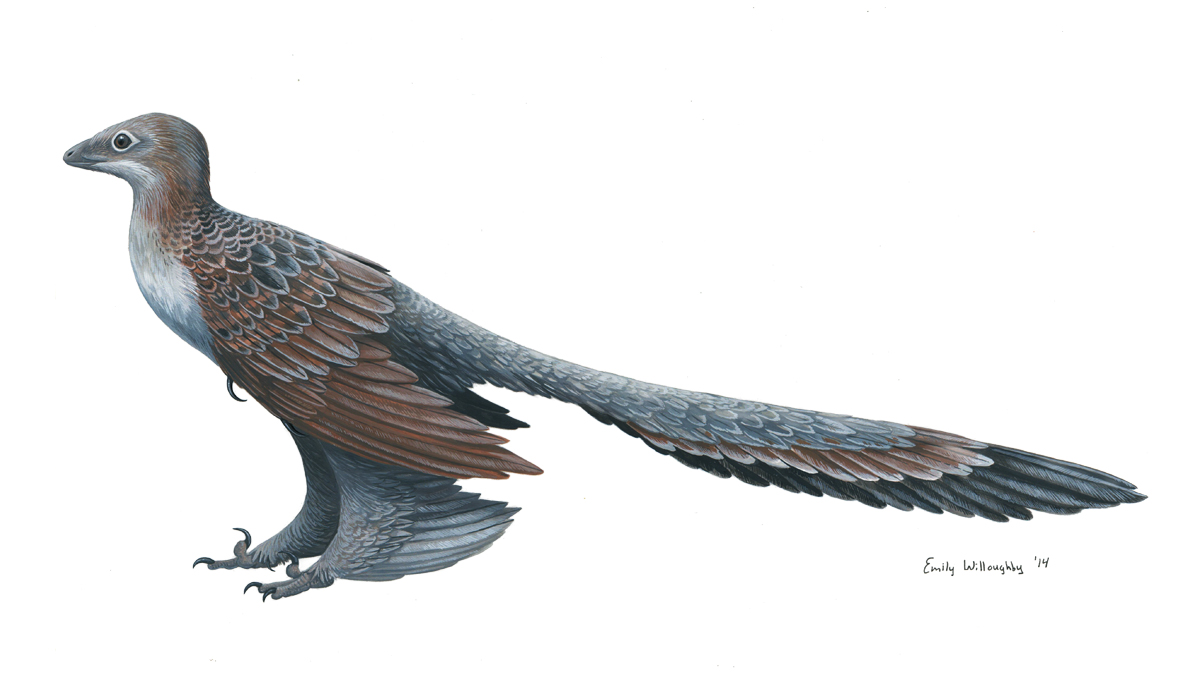ShopDreamUp AI ArtDreamUp
 EWilloughby on DeviantArthttps://www.deviantart.com/ewilloughby/art/Changyuraptor-469433992EWilloughby
EWilloughby on DeviantArthttps://www.deviantart.com/ewilloughby/art/Changyuraptor-469433992EWilloughbyDeviation Actions
Description
Changyuraptor yangi is a newly-described microraptorine dromaeosaur dinosaur from the early Cretaceous (Yixian formation) of Liaoning, China.
The animal would have been around 4 feet long in life, and its fossil shows that it was covered in feathers -- including, as in its smaller cousin Microraptor, a pair of "leg wings" represented by long paired pennaceous feathers on the metatarsals and tibiotarsus. One of Changyuraptor's most unique features is its voluminous tail feathers, and these feathers constitute the longest of any known non-avian dinosaur, with the most distal retrices reaching around 30 cm in length.
Changyuraptor is also by far the largest "four-winged" dinosaur known, and while this might not be as big of a deal as it sounds (given that there aren't very many "four-winged" dinosaurs), it does show that small size wasn't necessarily the gatekeeper to certain volant adaptations. I personally doubt that this animal was doing anything approaching powered flight, but the long tail feathers and multiple sets of long, well-developed lifting surfaces may have been a boon to gliding and controlled descent. The exceptionally long tail feathers therefore might have been used as a sort of "pitch control" device, wherein a large, relatively heavy animal would have needed especially fine-tuned control over rapid falls onto prey or in safe landings from higher ground. As Buzz Lightyear would say, "This isn't flying, it's falling with style!"
--
Gouache/watercolor paint on A3-size hot-pressed illustration board, approx. 5-6 hours.
The animal would have been around 4 feet long in life, and its fossil shows that it was covered in feathers -- including, as in its smaller cousin Microraptor, a pair of "leg wings" represented by long paired pennaceous feathers on the metatarsals and tibiotarsus. One of Changyuraptor's most unique features is its voluminous tail feathers, and these feathers constitute the longest of any known non-avian dinosaur, with the most distal retrices reaching around 30 cm in length.
Changyuraptor is also by far the largest "four-winged" dinosaur known, and while this might not be as big of a deal as it sounds (given that there aren't very many "four-winged" dinosaurs), it does show that small size wasn't necessarily the gatekeeper to certain volant adaptations. I personally doubt that this animal was doing anything approaching powered flight, but the long tail feathers and multiple sets of long, well-developed lifting surfaces may have been a boon to gliding and controlled descent. The exceptionally long tail feathers therefore might have been used as a sort of "pitch control" device, wherein a large, relatively heavy animal would have needed especially fine-tuned control over rapid falls onto prey or in safe landings from higher ground. As Buzz Lightyear would say, "This isn't flying, it's falling with style!"
--
Gouache/watercolor paint on A3-size hot-pressed illustration board, approx. 5-6 hours.
Gang Han et al. 2014. "A new raptorial dinosaur with exceptionally long feathering provides insights into dromaeosaurid flight performance". Nature Communications. 5: 4382.
Image size
1200x677px 263.34 KB
© 2014 - 2025 EWilloughby
Comments50
Join the community to add your comment. Already a deviant? Log In
Cute